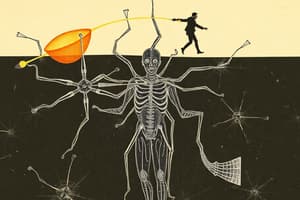Podcast
Questions and Answers
What is the approximate length of the head of the T₂ bacteriophage?
What is the approximate length of the head of the T₂ bacteriophage?
- 65 nm
- 50 nm
- 110 nm
- 93-100 nm (correct)
What type of genetic material does the T₂ bacteriophage contain?
What type of genetic material does the T₂ bacteriophage contain?
- Double-stranded DNA (correct)
- Single-stranded RNA
- Double-stranded RNA
- Single-stranded DNA
Which of the following is NOT a component of the T₂ bacteriophage tail?
Which of the following is NOT a component of the T₂ bacteriophage tail?
- Baseplate
- Spikes
- Envelope (correct)
- Collar
What is the length of the T₂ bacteriophage's tail?
What is the length of the T₂ bacteriophage's tail?
What structural feature gives coronaviruses their crown-like appearance?
What structural feature gives coronaviruses their crown-like appearance?
Which of the following coronaviruses is associated with the outbreak that began in 2003?
Which of the following coronaviruses is associated with the outbreak that began in 2003?
During which cycle do viruses replicate and then cause the host cell to lyse?
During which cycle do viruses replicate and then cause the host cell to lyse?
What does SARS-CoV-2 primarily bind to on human cells to enable its entry?
What does SARS-CoV-2 primarily bind to on human cells to enable its entry?
What is the approximate size of the RNA genome of coronaviruses?
What is the approximate size of the RNA genome of coronaviruses?
How many genes does the T₂ bacteriophage contain approximately?
How many genes does the T₂ bacteriophage contain approximately?
Study Notes
Bacteriophage T₂
- Bacteriophage T₂ is a well-known virus with a distinct structure.
- The virus has two main parts: the head and the tail.
- The head is hexagonal in shape with a length of 93-100 nm and width of 65 nm.
- The head contains double-stranded DNA, approximately 60,000 base pairs, with a length of 50 µm.
- The tail is located behind the head, measuring 95-110 nm long and 15-25 nm in diameter.
- The tail consists of a collar, a baseplate, spikes, and six tail fibers.
- All parts of the phage are made of proteins.
COVID-19
- Coronavirus, a large virus in the Coronaviridae family, has a crown-like appearance (corona = crown in Latin).
- It's characterized by a double-layered lipid envelope and a large RNA genome of approximately 27-32 kb.
- Four known coronaviruses exist, with three being zoonotic (human and animal).
- SARS-CoV (SARS) – emerged in 2003, originating from bats.
- MERS-CoV (MERS) – appeared in 2012, originating from bats via camels.
- SARS-CoV-2 – the virus causing COVID-19, presumed to be zoonotic.
- The virus causing COVID-19 was initially known as 2019-nCoV.
- COVID-19 is covered in many spike proteins, which bind to human cell proteins, allowing the virus to enter and replicate within host cells.
- The virus utilizes the host's machinery to duplicate its RNA and coat proteins.
Viral Replication
- Viruses lack their own replication mechanisms.
- They rely on the host cell's DNA replication machinery to create more viruses.
Lytic Cycle
- The lytic cycle is a process where a virus infects a host cell, replicates, and then causes the cell to burst, releasing new viruses.
- The lytic cycle of T₂ bacteriophage in Escherichia coli (E. coli) involves several steps:
- Attachment/Landing: The T₂ bacteriophage attaches to the E. coli cell wall through receptors on the cell's surface.
- The viral proteins align with the receptors, allowing the virus to enter the cell.
Studying That Suits You
Use AI to generate personalized quizzes and flashcards to suit your learning preferences.
Description
This quiz covers key features of two significant viruses: Bacteriophage T₂ and COVID-19. It explores the unique structures, genetic materials, and classifications of each virus, highlighting their importance in virology. Test your understanding of their characteristics and how they affect living organisms.




